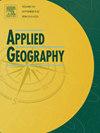利用多源大数据识别城市改造中的“双老化”街区——以北京为例
IF 5.4
2区 地球科学
Q1 GEOGRAPHY
引用次数: 0
摘要
长期以来,建筑存量老化一直是城市改造项目的主要问题。特别是,随着老年人的人-环境(P-E)失配日益严重,确定“双老龄化”社区已成为老年人友好型城市发展的主要挑战。以北京市为例,利用百度地图定位服务数据和安居客影像数据,对人口老龄化和建筑存量的空间格局进行了刻画,并运用能力-压力模型对社区双重老龄化程度进行了测度。结果表明:老龄化人口分布呈现出以城市核心为中心向外辐射的“高-低-高”梯度分布;老旧危房存量主要集中在二环内。遭受严重双重老化的街区在四环内形成了不同的集群。这些空间格局是由历史、经济和治理驱动因素的相互作用形成的。值得注意的是,大约30%受到双重老化严重影响的社区目前被排除在市政改造计划之外。本研究利用多源大数据和深度学习方法,为当前老龄化城市中急需改造的双老化街区识别提供了一种及时、创新的方法。本文章由计算机程序翻译,如有差异,请以英文原文为准。
Using multi-source big data to identify “double-aging” neighborhoods for urban retrofitting: A case study of Beijing
Building stock aging has long been a major concern in urban retrofitting programs. In particular, as the person-environment (P-E) mismatch becomes increasingly severe for older adults, identifying “double-aging” neighborhoods has become the main challenge for age-friendly city development. Taking Beijing, China as a case study, we used Baidu Map location-based service data and Anjuke imagery data to depict the spatial patterns of the aging population and building stock and applied the competence-press model to measure the degree of double aging in neighborhoods. The results showed that the distribution of the aging population follows a “high-low-high” gradient radiating outward from the urban core. The old and dilapidated building stocks are mainly concentrated within the 2nd Ring Road. Neighborhoods experiencing severe double aging form distinct clusters within the 4th Ring Road. These spatial patterns are shaped by the interplay of historical, economic, and governance-driven factors. Notably, approximately 30 % of neighborhoods severely affected by double aging are currently excluded from municipal retrofitting plans. By using multi-source big data and deep-learning methods, this study provides a timely and innovative approach to identifying double-aging neighborhoods in urgent need of urban retrofitting in currently aging cities.
求助全文
通过发布文献求助,成功后即可免费获取论文全文。
去求助
来源期刊

Applied Geography
GEOGRAPHY-
CiteScore
8.00
自引率
2.00%
发文量
134
期刊介绍:
Applied Geography is a journal devoted to the publication of research which utilizes geographic approaches (human, physical, nature-society and GIScience) to resolve human problems that have a spatial dimension. These problems may be related to the assessment, management and allocation of the world physical and/or human resources. The underlying rationale of the journal is that only through a clear understanding of the relevant societal, physical, and coupled natural-humans systems can we resolve such problems. Papers are invited on any theme involving the application of geographical theory and methodology in the resolution of human problems.
 求助内容:
求助内容: 应助结果提醒方式:
应助结果提醒方式:


